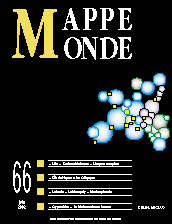

Didier Paris. Lille, from metropolis to urban region (9 fig.)
Since the late 1980s, the development of Lille has hinged on a strategy of metropolisation. The success of this strategy depends largely on local political and economic actors' capacity to join in a process of governance and address the key issue of regional development and solidarity implicit in the need for urban revival. This process is linked to a cross-border regional system structured as a network of high-density towns located close together.
keyword: LILLE, METROPOLISATION, URBAN REGION, URBAN REVIVAL
Raymond Wssner. Southern Rhine: neofordist region, cluster or technopole? (4 fig.)
An industrial region can be defined by the type of productive system deployed there. With two giant plants in Sochaux and Mulhouse, PSA has a considerable part in shaping the destiny of the Southern Rhine region. The region has surmounted the crisis of Fordism, but growth could now take one of several possible scenarios for the relationship between a large corporation and local development actors.
keyword: ALSACE, AUTOMOTIVE INDUSTRY, CLUSTER, FORDISM, FRANCHE-COMTÉ, PARADIGM, TECHNOPOLE
Roger Brunet. Lines of force of the European space (5 fig.)
Europe is structured by several geographical figures - a double dissymmetry, a powerful transversal dorsal, a ring of rich cities encircled by changing peripheries, and a grid of actual and potential major routes - but it remains divided by borders and their associated centralities. The appearance of new figures (arcs) and progress towards a unified Europe are altering this picture, but real integration of the European territory requires embarking on the requisite «major projects».
keyword: ARC, BLUE BANANA, BORDER, CENTRALITY, DISSYMMETRY, EUROPE, GRID, INTEGRATION, MEGALOPOLIS, NETWORK, RING
Philippe Violier. La Baule, from tourism to lived space (5 fig.)
Created by and for tourism, some resorts are now shifting out of tourism. The diversification of their functions, related to the increasing mobility of society, affects and sometimes disrupts the tourism function. A new space develops from the transformation of spaces previously appropriated by tourism into other patterns, derived from or contrasting with tourism. The case of La Baule is used as an illustration of these changes.
keyword: BEACH RESORT, CHANGING TOURIST AREAS, LA BAULE, LOIRE-ATLANTIQUE, TOURISM
Anne Hertzog. Museums, space and territorial identity in Picardy (6 fig.)
The exhibition of objects in museums establishes a particular relationship to place and territory. A cultural and tourist amenity, a museum is also a vehicle of territorial identity. A few simple figures reveal the pattern of museums opened in Picardy at different times. They show that the distribution of museums reflects spatial logics and dynamics specific to Picardy.
keyword: CULTURAL GEOGRAPHY, HERITAGE, IDENTITY, MUSEUMS, PICARDY
Gilles Fumey. A geography of imaginary countries (2 fig.)
Even though the entire surface of the globe has been appropriated, individuals or small groups of usurpers, conquerors or adventurers continue to lay claim to territories. These "conquests" may be of physical or virtual spaces. They suggest the importance that people place on having a territorial base, which, consistently throughout history, has been seen as an antidote to all forms of organisation that people no longer feel comfortable with.
keyword: STATE, TERRITORY
Marie-Françoise Fleury, Hervé Théry. The worldwide success of Monopoly (4 fig.)
Monopoly is a board game known all over the world, with many national versions. A geographical analysis of their distribution is an excellent example of diffusion. The choice of cities in whose streets people play reveals the limits of the areas of influence of some of the major powers - a real geography of the game.
keyword: DIFFUSION, GAME, GLOBALISATION, MONOPOLY, NATIONAL MODELS
Christophe Grenier. Oceanian or American? A comparative analysis of the attachment of the Galapagos and Easter Island to America (7 fig.)
Extremely isolated prior to their attachment to America through similar processes, the Galapagos archipelago and Easter Island were open spaces or trap doors in the world-system until they were integrated into Ecuador and Chile respectively through their airports, the development of tourism based on their scientific fame, and immigration from the mainland.
keyword: AMERICA, EASTER ISLAND, GALÁPAGOS, INSULARITY, ISOLATION, PACIFIC
Book reviews (Roger Brunet, Patricia Cicille, Sébastien Velut)
Mappemonde 1/02![]()
![]() Mappemonde 3/02
Mappemonde 3/02
For subscribe or buy this issue: BELIN
Last modified: August 22, 2002